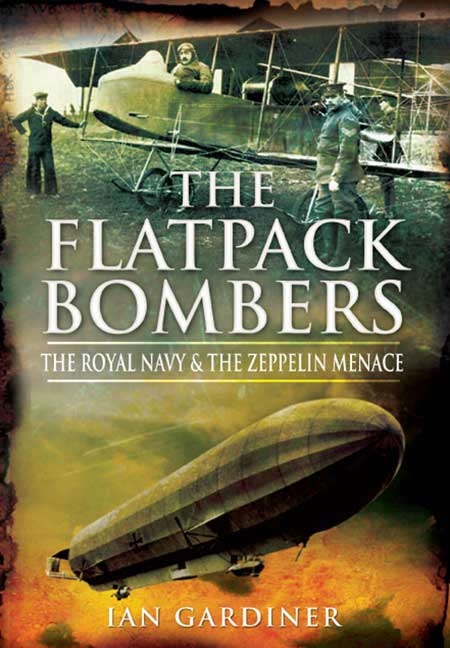The Flatpack Bombers (Hardback)
The Royal Navy and the Zeppelin Menace
Imprint: Pen & Sword Military
Pages: 163
ISBN: 9781848840713
Published: 21st May 2009
Last Released: 4th April 2024
(click here for international delivery rates)
Need a currency converter? Check XE.com for live rates
| Other formats available | Price |
|---|---|
| The Flatpack Bombers Paperback Add to Basket | £12.99 |
| The Flatpack Bombers ePub (5.1 MB) Add to Basket | £6.99 |
Our vision of aviation in the First World War is dominated by images of gallant fighter pilots duelling with each other high over the Western Front. But it was the threat of the Zeppelin which spurred the British government into creating the Royal Flying Corps, and it was this 'menace', which no aircraft could match in the air at the beginning of the war, which led Winston Churchill and the Royal Navy to set about bombing these airships on the ground. Thus in 1914, the Royal Naval Air Service, with their IKEA-style flatpack aeroplanes, pioneered strategic bombing. Moreover, through its efforts to extend its striking range in order to destroy Zeppelins in their home bases, the Royal Navy developed the first true aircraft carriers.
This book is the story of those largely forgotten very early bombing raids. It explains the military and historical background to the first British interest in military and naval aviation, and why it was that the Navy pursued long distance bombing, while the Army concentrated on reconnaissance. Every bomber raid, and every aircraft carrier strike operation since, owes its genesis to those early naval flyers, and there are ghosts from 1914 which haunt us still today.
A good buy.
The Long, Long Trail
This is a rewarding read and goes some way to recognising the immense contribution made by British naval aviators to modern aerial warfare, demonstrating how to employ aerial weapons systems tactically and strategically.
Firetrench
There is really nothing new under the sun - when was the first British air raid on Germany; the first destruction of a Zeppelin by an aircraft; the first long range strategic bombing raid; the first sea battle conducted entirely using air assets? 1916 0 1918 0 1942? In fact all of the above had taken place within the space of three months in the autumn and winter of 1914 and all were carried out by a formation whose contribution to the development of military aviation has been somewhat neglected, the Royal Naval Air Service (RNAS). Indeed the just recently concluded mission of the Naval Strike Wing in Afghanistan can trace its ancestory back to the Avro 504s at Belfort in Nomvember 1914.
Ulster Airmail
In his splendid foreword, Professor Geoffrey Till notes that the author, a retired senior officer in the Royal Marines, has written a book that can only be enjoyed as a stirring tale but also as a cogent analysis of the introduction and exploitation of emerging technology. I would heartily agree with this and would endorse the conclusions reached by the author - especially as they agree with those i have come to during research for two forthcoming books of my own!
He examines in some detail but in a lively and entertaining way, the attempts to bomb Düsseldorf, Cologne, Friedrichshafen and Cuxhaven by the RNAS and puts the story of these in the context of the contemporary perception of the "Zeppelin Menace" and the political and military will to do something about it. We know that the Zeppelin was not the war-winning terror weapon it was feared to be but was in fact a technological cul-de-sac - the important point here is that this was far from the case in 1914 - we simply did not know how effective air power could be or what indeed was its best use.
It is obvious that the author has read widely and well; he wears his scholarship lightly and covers the ground at a good pace without missing the important points.His list of sources is impressive and his quotations and references are all most apposite. He has an obvious feeling and empathy for the period and for the men of this time - the description of the cloak and being particularly enjoyable. His opening and concluding chapters are particularly good as primers on technical developements pre-war and on the evolution of naval air power after 1914. The air attacks described were not a great success (except in the case of Reggie Marix Düsseldorf on October 7, 1914)but they were indicative of forward thinking and innovative minds being bought to bear on a totally new dimension of warfare.
The text is enhanced by well-chosen and well-produced photographs, as well sas three simple but effective, hand-drawn maps. Highly recommended.
There is really nothing new under the sun - when was the first British air raid on Germany; the first destruction of a Zeppelin by an aircraft; the first long range strategic bombing raid; the first sea battle conducted entirely using air assets? 1916 - 1918 - 1942? In fact all of the above had taken place within the space of three months in the autumn and winter of 1914 and all were carried out by a formation whose contribution to the development of military aviation has been somewhat neglected, the Royal Naval Air Service (RNAS). Indeed the just recently concluded mission of the Naval Strike Wing in Afghanistan can trace its ancestry back to the Avro 504s at Belfort in November 1914.
Aviation World Magazine
In his splendid foreword, Professor Geoffrey Till notes that the author, a retired senior officer in the Royal Marines, has written a book that can not only be enjoyed as a stirring tale but also as a cogent analysis of the introduction and exploitation of emerging technology. I would heartily agree with this and would endorse the conclusions reached by the author - especially as they agree with those I have come to during research for two forthcoming books of my own! He examines in some detail but in a lively and entertaining way, the attempts to bomb Diisseldorf, Cologne, Friedrichshafen and Cuxhaven by the RNAS and puts the story of these in the context of the contemporary perception of the "Zeppelin Menace" and the political and military will to do something about it. We now know that the Zeppelin was not the war-winning terror weapon it was feared to be but was in fact a technological cul-de-sac - the important point here is that this was far from the case in 1914 - we simply did not know how effective air power could be or what indeed was its best use.




















